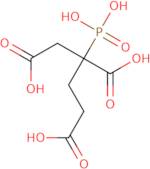
2-Phosphonobutane-1,2,4-tricarboxylic acid, 50% aqueous solution
CAS: 37971-36-1
Ref. 3D-FP45281
| 1kg | 416,00 € | ||
| 2kg | 669,00 € | ||
| 500g | 329,00 € |
Información del producto
- 1,2,4-Butanetricarboxylic acid, 2-phosphono-
- 1,2,4-Tricarboxy-sec-butylphosphonic acid
- 2-Phosphonbutane-1,2,4-tricarboxylic acid
- 2-Phosphono butane-1,2,4-tricarboxylic acid
- 2-Phosphono-1,2,4-butanetricarboxylic acid
- 2-Phosphonobutane-1,1,1-Tricarboxylic Acid
- 2-Phosphonobutyl-1,2,4-tricarboxylic acid
- 3-Carboxy-3-phosphonohexanedioic acid
- Bayhibit AM
- Bayhibit AM 50
- Ver más sinónimos
- Belclene 650
- Chelest PH 430
- Cublen P 50
- Dequest 7000
- Jh 906
- Mayoquest 2100
- Pbdca
- Pbs-Am
- Pbtc
- Pbtca
- Phosphonobutanetricarboxylic acid
- 2-Phosphonobutane-1,2,4-Tricarboxylic Acid (PBTC)
Please enquire for more information about 2-Phosphonobutane-1,2,4-tricarboxylic acid, 50% aqueous solution including the price, delivery time and more detailed product information at the technical inquiry form on this page
Propiedades químicas
Consulta técnica sobre: 3D-FP45281 2-Phosphonobutane-1,2,4-tricarboxylic acid, 50% aqueous solution
Si desea solicitar un presupuesto o realizar un pedido, por favor añada los productos deseados a su carrito y solicite un presupuesto o pedido desde el carrito. Es más rápido, más barato, y podrá beneficiarse de los descuentos y las ventajas disponibles.





